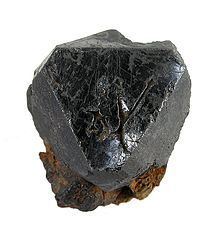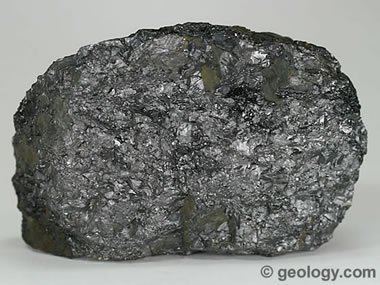Category Oxide mineral Dana classification 04.03.05.01 | Strunz classification 4.CB.05 Crystal system Trigonal | |
 | ||
Crystal class Rhombohedral (3)H-M symbol: (3) | ||
Grades of ilmenite
Ilmenite is the titanium-iron oxide mineral with the idealized formula FeTiO
3. It is a weakly magnetic black or steel-gray solid. From the commercial perspective, ilmenite is the most important ore of titanium. Ilmenite is the main source of titanium dioxide, which is used in paints, fabrics, plastics, paper, sunscreen, food and cosmetics.
Contents
- Grades of ilmenite
- Ilmenite
- Structure and properties
- Mineral chemistry
- Paragenesis
- Processing and consumption
- Alloys
- Feedstock production
- Lunar ilmenite
- References

Ilmenite
Structure and properties

Ilmenite crystallizes in the trigonal system. The ilmenite crystal structure consists of an ordered derivative of the corundum structure; in corundum all cations are identical but in ilmenite Fe2+ and Ti4+ ions occupy alternating layers perpendicular to the trigonal c axis. Containing high spin ferrous centers, ilmenite is paramagnetic.

Ilmenite is commonly recognized in altered igneous rocks by the presence of a white alteration product, the pseudo-mineral leucoxene. Often ilmenites are rimmed with leucoxene, which allows ilmenite to be distinguished from magnetite and other iron-titanium oxides. The example shown in the image at right is typical of leucoxene-rimmed ilmenite.
In reflected light it may be distinguished from magnetite by more pronounced reflection pleochroism and a brown-pink tinge.
Samples of ilmenite exhibit a weak response to a hand magnet.
Mineral chemistry

Ilmenite most often contains appreciable quantities of magnesium and manganese and the full chemical formula can be expressed as (Fe,Mg,Mn,Ti)O3. Ilmenite forms a solid solution with geikielite (MgTiO
3) and pyrophanite (MnTiO
3) which are magnesian and manganiferous end-members of the solid solution series.
Although there appears evidence of the complete range of mineral chemistries in the (Fe,Mg,Mn,Ti)O3 system naturally occurring on Earth, the vast bulk of ilmenites are restricted to close to the ideal FeTiO
3 composition, with minor mole percentages of Mn and Mg. A key exception is in the ilmenites of kimberlites where the mineral usually contains major amounts of geikielite molecules, and in some highly differentiated felsic rocks ilmenites may contain significant amounts of pyrophanite molecules.
At higher temperatures it has been demonstrated there is a complete solid solution between ilmenite and hematite. There is a miscibility gap at lower temperatures, resulting in a coexistence of these two minerals in rocks but no solid solution. This coexistence may result in exsolution lamellae in cooled ilmenites with more iron in the system than can be homogeneously accommodated in the crystal lattice.
Altered ilmenite forms the mineral leucoxene, an important source of titanium in heavy mineral sands ore deposits. Leucoxene is a typical component of altered gabbro and diorite and is generally indicative of ilmenite in the unaltered rock.
Paragenesis
Ilmenite is a common accessory mineral found in metamorphic and igneous rocks. It is found in large concentrations in layered intrusions where it forms as part of a cumulate layer within the silicate stratigraphy of the intrusion. Ilmenite generally occurs within the pyroxenitic portion of such intrusions (the 'pyroxene-in' level).
Magnesian ilmenite is indicative of kimberlitic paragenesis and forms part of the MARID association of minerals (mica-amphibole-rutile-ilmenite-diopside) assemblage of glimmerite xenoliths. Manganiferous ilmenite is found in granitic rocks and also in carbonatite intrusions where it may also contain anomalous niobium.
Many mafic igneous rocks contain grains of intergrown magnetite and ilmenite, formed by the oxidation of ulvospinel. Ilmenite also occurs as discrete grains, typically with some hematite in solid solution, and complete solid solution exists between the two minerals at temperatures above about 950 °C.
Titanium was identified for the first time by William Gregor in 1791 in ilmenite from the Manaccan valley in Cornwall, southwest England.
Ilmenite is named after the locality of its discovery in the Ilmensky Mountains, near Miass, Russia.
Processing and consumption
Most ilmenite is mined for titanium dioxide production. In 2011, about 47% of the titanium dioxide produced worldwide were based on this material. Finely ground titanium dioxide is a bright white powder widely used as a base pigment in paint, paper and plastics. Metallic Titanium can be easily derived from it for uses such as aircraft and high-strength steel devices.
North America and Europe together consume about 50% of the world's titanium dioxide production. Demand by India and China is growing rapidly and may eventually surpass Western consumption.
Ilmenite is ultimately converted into pigment grade titanium dioxide via either the sulfate process or the chloride process. Sulfate process plants must utilise low-vanadium ilmenite, as vanadium is a penalty element. Titanium dioxide pigment can also be produced from higher titanium content feedstocks such as upgraded slag, rutile and leucoxene via a chloride acid process. Sulfate and chloride process pigment tends to be used for lower and higher quality applications respectively, users more and more preferring the chloride process. The five largest TiO
2 pigment processors are Dupont, Cristal Global, Huntsman, Kronos and Tronox, Dupont having pioneered the chloride process in the 1960s and having converted to the use of the chloride process for all its applications. Major paint and coating company end users for pigment grade titanium dioxide include Akzo Nobel, PPG Industries, Sherwin Williams, BASF, Kansai Paints and Valspar. Global TiO
2 pigment demand for 2010 was 5.3 Mt with annual growth expected to be about 3-4%.
Most ilmenite ore production from Canada, South Africa and Norway is destined for titaniferous slag application. Carbon (anthracite) and energy are added in large electric arc smelting furnaces to convert the ilmenite into molten iron bath and slag rich in titanium dioxide. The iron can be further processed as pig iron, as continuous cast steel billets, or as iron or steel powders. A related chemically process technology is termed the Becher process.
Ilmenite ore is used as a flux by steelmakers to line blast furnace hearth refractory.
Ilmenite sand is also used as a sandblasting agent in the cleaning of diecasting dies.
Alloys
Ilmenite is an ingredient in the manufacture of the ferrotitanium and ferro-carbon-titanium alloys.
Feedstock production
Australia was the world's largest ilmenite ore producer in 2011, with about 1.3 million tonnes of production, followed by South Africa, Canada, Mozambique, India, China, Vietnam, Ukraine, Norway, Madagascar and United States.
Although most ilmenite is recovered from heavy mineral sands ore deposits, ilmenite can also be recovered from layered intrusive sources or "hard rock" titanium ore sources.
The top four ilmenite and rutile feedstock producers in 2010 were Rio Tinto Group, Iluka Resources, Exxaro and Kenmare Resources, which collectively accounted for more than 60% of world's supplies.
The world's two largest open cast ilmenite mines are:
2 reserves.
Major mineral sands based ilmenite mining operations include:
Attractive major potential ilmenite deposits include:
2 and 0.64% V
2O
5, one of the richest magnetite-ilmenite ore bodies in Australia
Lunar ilmenite
Ilmenite has been found in Moon rocks, and is typically highly enriched in magnesium similar to the kimberlitic association. In 2005 NASA used the Hubble Space Telescope to locate potentially ilmenite-rich locations. This mineral could be essential to an eventual Moon base, as ilmenite would provide a source of iron and titanium for the building of structures and essential oxygen extraction.
